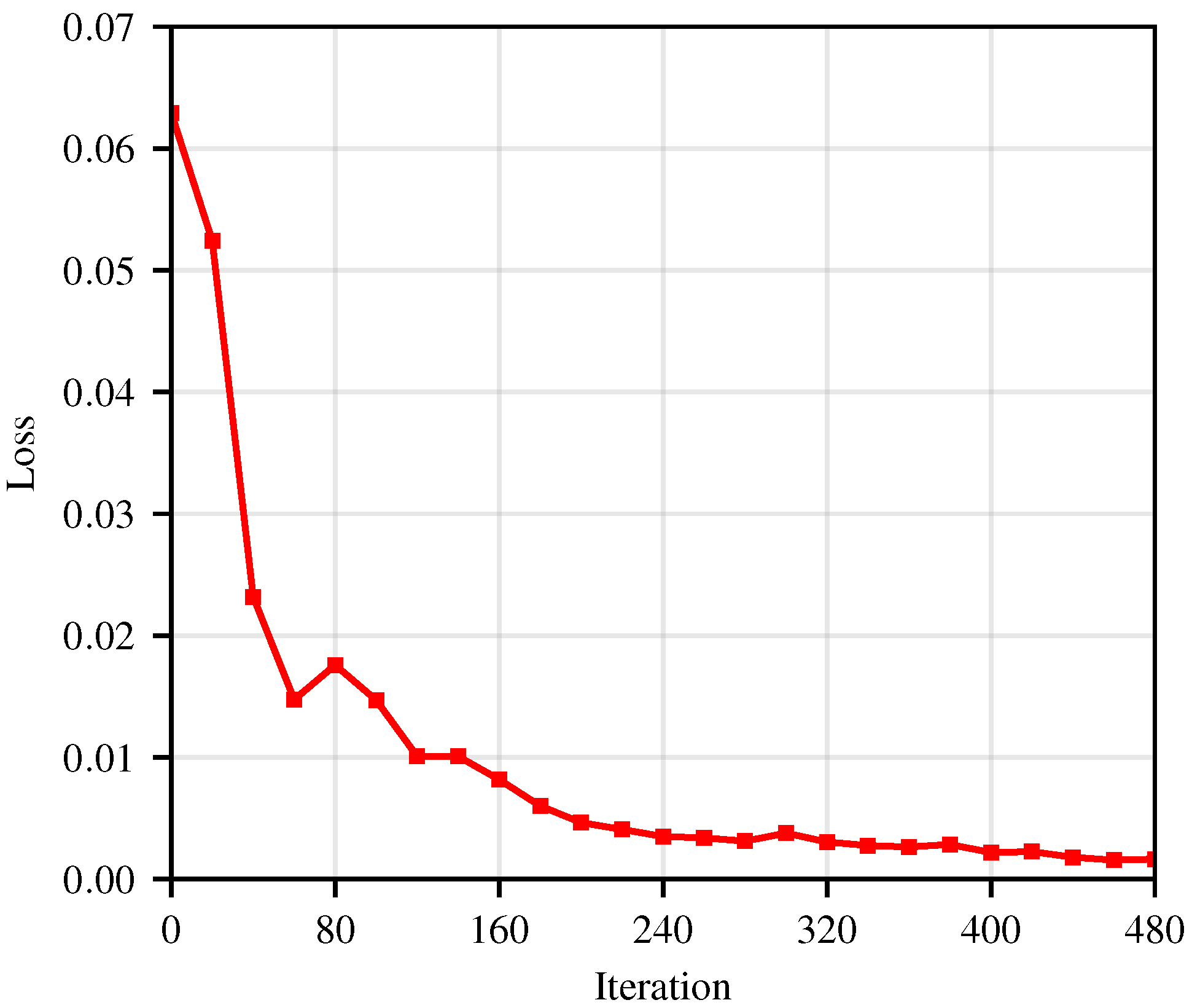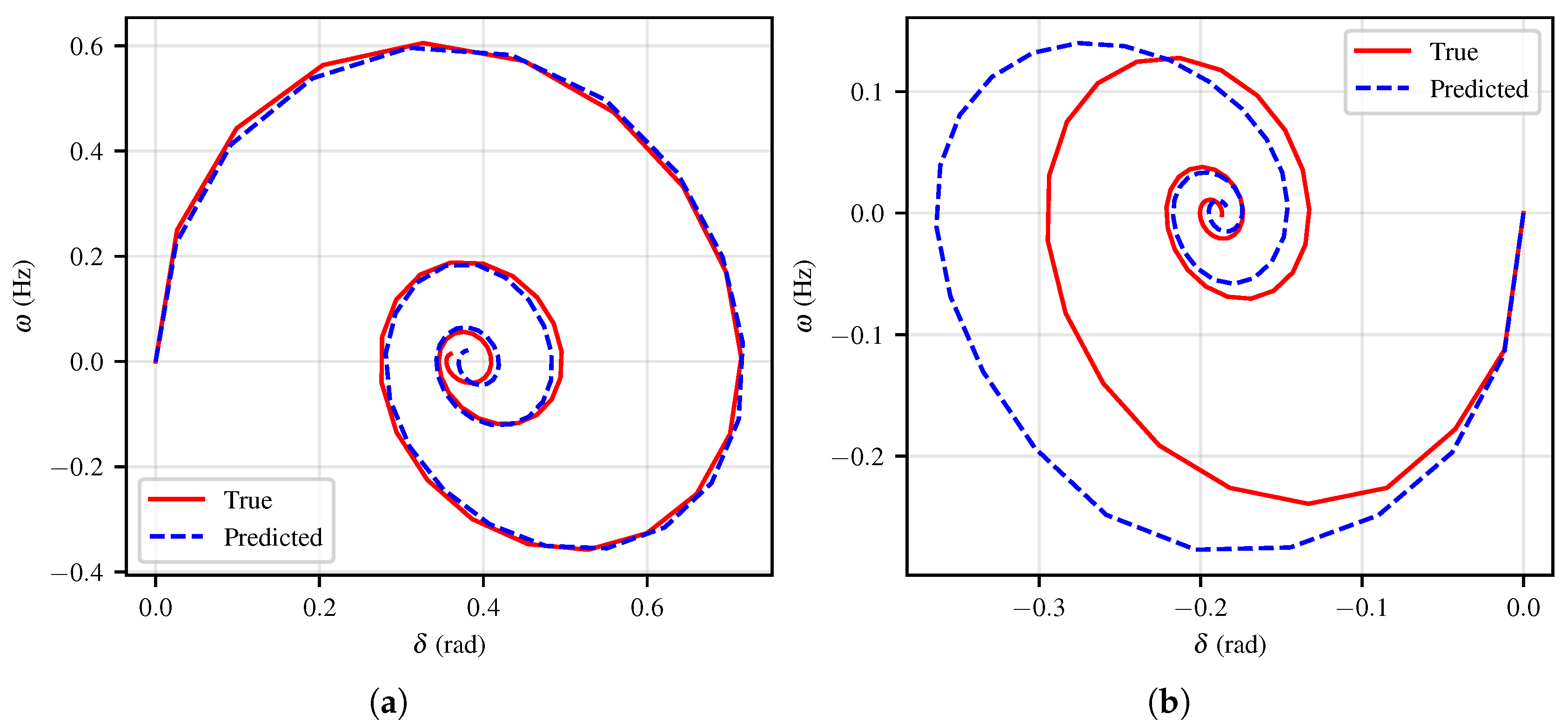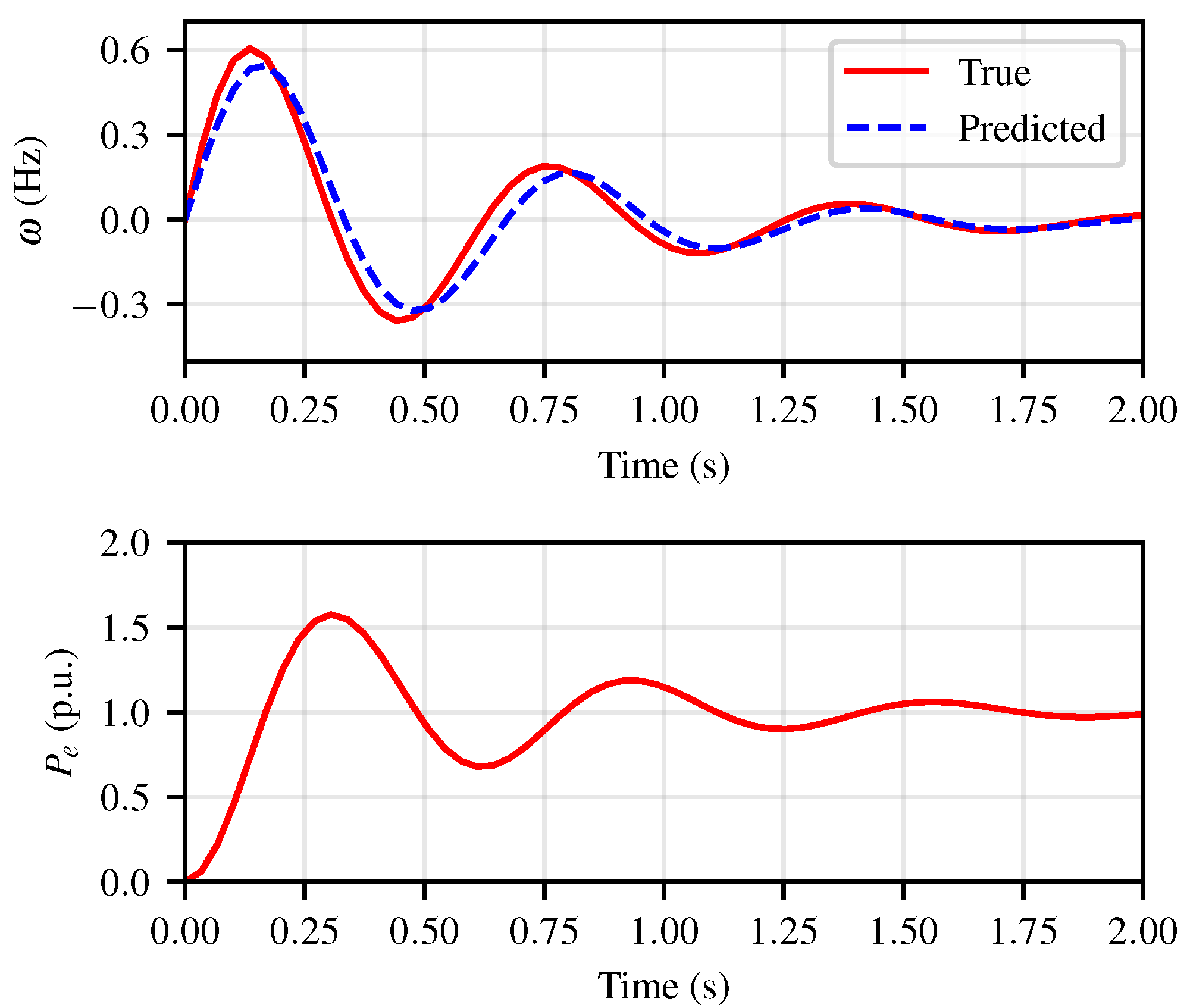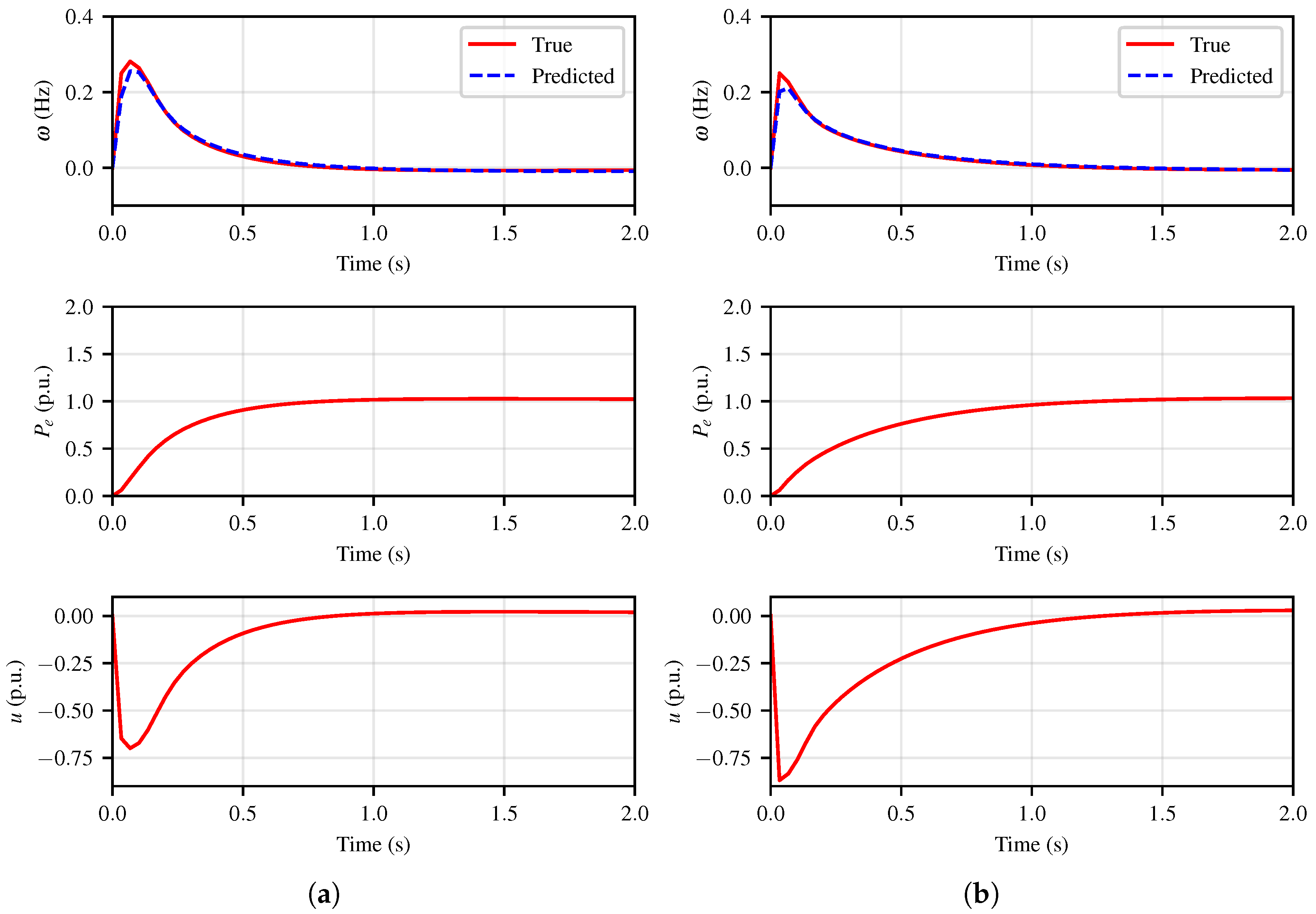Neural ODE-Based Frequency Stability Assessment and Control of Energy Storage Systems
Abstract
1. Introduction
| Category | Method | Modeling Approach |
|---|---|---|
| Model-based methods | State–space model [6], physical modeling [5], etc. | Physics-based equations |
| Data-driven methods | Decision tree [9], SVM [10], DBN [12], etc. | Discrete-time black-box models |
| Hybrid methods | Model and data-driven [4] | Partial modeling and data completion |
2. Methodology
2.1. Frequency Stability Assessment
2.2. Neural Frequency Control
2.3. Algorithm
| Algorithm 1 Optimizing neural ODE model and controller |
| Input: Power system environment f; Output: Parameters of neural ODE model and ; 1: Initialize the parameters and ; 2: for epoch do 3: for episode do 4: Obtain the initial state and system disturbance d; 5: for do 6: Execute control input ; 7: Observe the next state ; 8: end for 9: Store the trajectory in the buffer; 10: end for 11: for do 12: Sampling a trajectory from buffer; 13: Predict the trajectory through with the inital value ; 14: Compute the loss function L; 15: Compute the gradient ; 16: ; 17: end for 18: for do 19: Predict the trajectory through with the inital value ; 20: Compute the objective function J; 21: Compute the gradient ; 22: ; 23: end for 24: end for |
3. Simulation Results
4. Conclusions
Author Contributions
Funding
Institutional Review Board Statement
Informed Consent Statement
Data Availability Statement
Conflicts of Interest
References
- Hatziargyriou, N.; Milanovic, J.; Rahmann, C.; Ajjarapu, V.; Canizares, C.; Erlich, I.; Hill, D.; Hiskens, I.; Kamwa, I.; Pal, B.; et al. Definition and classification of power system stability–revisited & extended. IEEE Trans. Power Syst. 2020, 36, 3271–3281. [Google Scholar]
- Zhang, Y.; Wu, S.; Lin, J.; Wu, Q.; Shen, C.; Liu, F. Frequency reserve allocation of large-scale RES considering decision-dependent uncertainties. IEEE Trans. Sustain. Energy 2023, 15, 339–354. [Google Scholar] [CrossRef]
- Hu, W.; Lu, Z.; Wu, S.; Zhang, W.; Dong, Y.; Yu, R.; Liu, B. Real-time transient stability assessment in power system based on improved SVM. J. Mod. Power Syst. Clean Energy 2019, 7, 26–37. [Google Scholar] [CrossRef]
- Wang, Q.; Li, F.; Tang, Y.; Xu, Y. Integrating model-driven and data-driven methods for power system frequency stability assessment and control. IEEE Trans. Power Syst. 2019, 34, 4557–4568. [Google Scholar] [CrossRef]
- Egido, I.; Fernandez-Bernal, F.; Centeno, P.; Rouco, L. Maximum frequency deviation calculation in small isolated power systems. IEEE Trans. Power Syst. 2009, 24, 1731–1738. [Google Scholar] [CrossRef]
- Stanojev, O.; Markovic, U.; Aristidou, P.; Hug, G.; Callaway, D.; Vrettos, E. MPC-based fast frequency control of voltage source converters in low-inertia power systems. IEEE Trans. Power Syst. 2020, 37, 3209–3220. [Google Scholar] [CrossRef]
- Zhang, Y.; Xu, Y.; Dong, Z.Y. Robust ensemble data analytics for incomplete PMU measurements-based power system stability assessment. IEEE Trans. Power Syst. 2017, 33, 1124–1126. [Google Scholar] [CrossRef]
- Conte, F.; Massucco, S.; Paolone, M.; Schiapparelli, G.P.; Silvestro, F.; Zuo, Y. Frequency stability assessment of modern power systems: Models definition and parameters identification. Sustain. Energy Grids Netw. 2020, 23, 100384. [Google Scholar] [CrossRef]
- He, M.; Zhang, J.; Vittal, V. Robust online dynamic security assessment using adaptive ensemble decision-tree learning. IEEE Trans. Power Syst. 2013, 28, 4089–4098. [Google Scholar] [CrossRef]
- Baltas, N.G.; Mazidi, P.; Ma, J.; de Asis Fernandez, F.; Rodriguez, P. A comparative analysis of decision trees, support vector machines and artificial neural networks for on-line transient stability assessment. In Proceedings of the 2018 International Conference on Smart Energy Systems and Technologies (SEST), Sevilla, Spain, 10–12 September 2018; pp. 1–6. [Google Scholar]
- Liu, R.; Verbič, G.; Xu, Y. A new reliability-driven intelligent system for power system dynamic security assessment. In Proceedings of the 2017 Australasian Universities Power Engineering Conference (AUPEC), Melbourne, Australia, 19–22 November 2017; pp. 1–6. [Google Scholar]
- Zheng, L.; Hu, W.; Zhou, Y.; Min, Y.; Xu, X.; Wang, C.; Yu, R. Deep belief network based nonlinear representation learning for transient stability assessment. In Proceedings of the 2017 IEEE Power & Energy Society General Meeting, Chicago, IL, USA, 16–20 July 2017; pp. 1–5. [Google Scholar]
- Zhao, T.; Yue, M.; Wang, J. Deep-learning-based Koopman modeling for online control synthesis of nonlinear power system transient dynamics. IEEE Trans. Ind. Inform. 2023, 19, 10444–10453. [Google Scholar] [CrossRef]
- Chen, R.T.; Rubanova, Y.; Bettencourt, J.; Duvenaud, D.K. Neural ordinary differential equations. Adv. Neural Inf. Process. Syst. 2018, 31. [Google Scholar]
- Buşoniu, L.; De Bruin, T.; Tolić, D.; Kober, J.; Palunko, I. Reinforcement learning for control: Performance, stability, and deep approximators. Annu. Rev. Control. 2018, 46, 8–28. [Google Scholar] [CrossRef]
- Schmidhuber, J. Deep learning in neural networks: An overview. Neural Netw. 2015, 61, 85–117. [Google Scholar] [CrossRef] [PubMed]
- Ainsworth, S.; Lowrey, K.; Thickstun, J.; Harchaoui, Z.; Srinivasa, S. Faster policy learning with continuous-time gradients. In Proceedings of the Learning for Dynamics and Control, Online, 7–8 June 2021; pp. 1054–1067. [Google Scholar]
- Markovic, U.; Chu, Z.; Aristidou, P.; Hug, G. LQR-based adaptive virtual synchronous machine for power systems with high inverter penetration. IEEE Trans. Sustain. Energy 2018, 10, 1501–1512. [Google Scholar] [CrossRef]
- Cui, H.; Li, F.; Tomsovic, K. Hybrid symbolic-numeric framework for power system modeling and analysis. IEEE Trans. Power Syst. 2020, 36, 1373–1384. [Google Scholar] [CrossRef]






| Controller | IAE (Hz) | Nadir (Hz) |
|---|---|---|
| MPC [12] | 0.0356 | −0.1670 |
| Proposed | 0.0314 | −0.1127 |
| w/o control | 0.1019 | −0.2392 |
Disclaimer/Publisher’s Note: The statements, opinions and data contained in all publications are solely those of the individual author(s) and contributor(s) and not of MDPI and/or the editor(s). MDPI and/or the editor(s) disclaim responsibility for any injury to people or property resulting from any ideas, methods, instructions or products referred to in the content. |
© 2025 by the authors. Licensee MDPI, Basel, Switzerland. This article is an open access article distributed under the terms and conditions of the Creative Commons Attribution (CC BY) license (https://creativecommons.org/licenses/by/4.0/).
Share and Cite
Gao, S.; Liu, E.; Wu, Z.; Li, J.; Zhang, M. Neural ODE-Based Frequency Stability Assessment and Control of Energy Storage Systems. Appl. Sci. 2025, 15, 12048. https://doi.org/10.3390/app152212048
Gao S, Liu E, Wu Z, Li J, Zhang M. Neural ODE-Based Frequency Stability Assessment and Control of Energy Storage Systems. Applied Sciences. 2025; 15(22):12048. https://doi.org/10.3390/app152212048
Chicago/Turabian StyleGao, Song, Enren Liu, Zhuorui Wu, Jun Li, and Meng Zhang. 2025. "Neural ODE-Based Frequency Stability Assessment and Control of Energy Storage Systems" Applied Sciences 15, no. 22: 12048. https://doi.org/10.3390/app152212048
APA StyleGao, S., Liu, E., Wu, Z., Li, J., & Zhang, M. (2025). Neural ODE-Based Frequency Stability Assessment and Control of Energy Storage Systems. Applied Sciences, 15(22), 12048. https://doi.org/10.3390/app152212048







